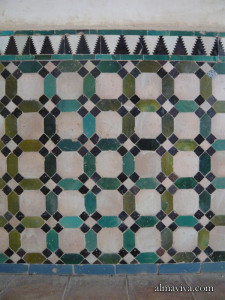The word zellige certainly has the same origin as azulejos. It is an ornamental technique that has grown in Spain and North Africa since the 12th century. It has became an integral part of Moroccan architecture where the finest examples can be admired. Its manufacturing process is reminiscent of both the mosaic and marquetry. Mud bricks are glazed, these monochrome bricks are baked, cut into geometric shapes (squares, diamonds, triangles, stars, crosses, various polygons …) and then combined to form joint geometric drawings, sometimes extremely complex. The edges of the sherds are chamfered so that when assembled, joints can be as thin as possible. A second method is to scrape the enamel colour coat to design a pattern; the bare clay remaining on the rest of the tile. With this method the rigour of geometry is avoided and curves can be introduced.
It is related the moorish alicatado technique admired in Spain in palaces like the Alhambra of Granada.
See many examples in our gallery of zellige.
Return to ceramic keywords.





